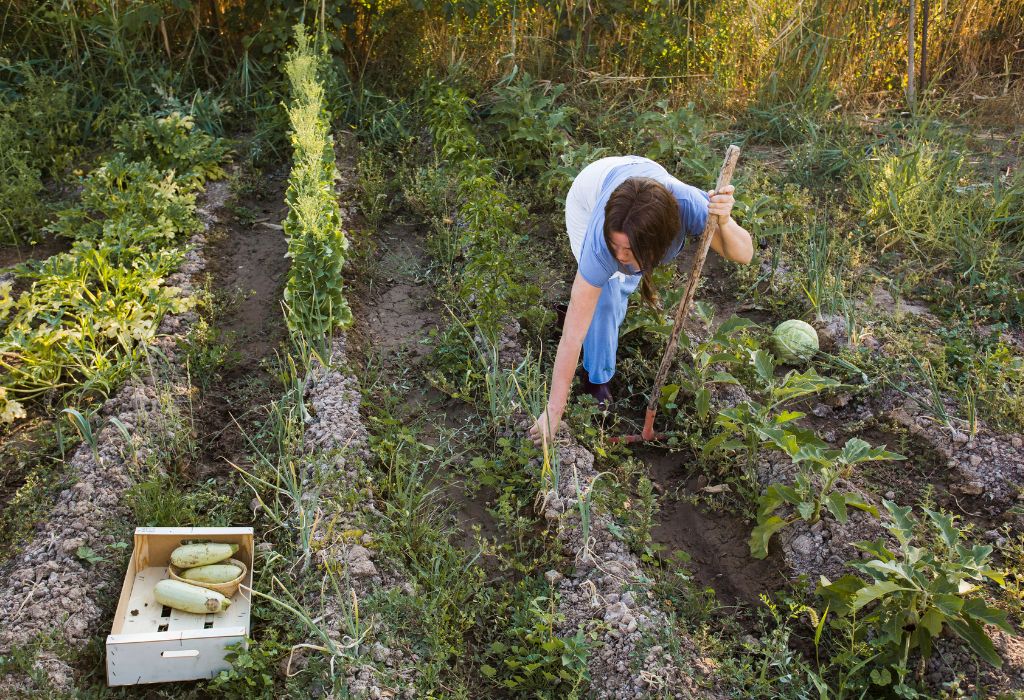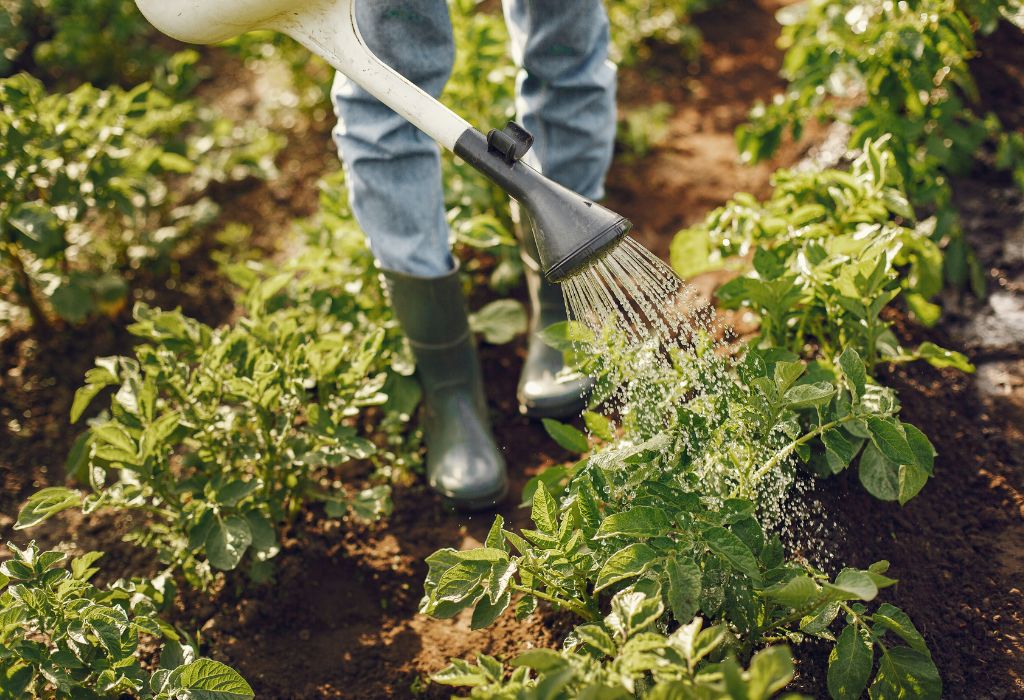Few things frustrate gardeners more than weeds invading a carefully planted vegetable patch. You spend hours preparing soil, planting seeds, and watering diligently—only to find aggressive weeds competing for space within days.
The problem isn’t small. Studies show weeds can reduce vegetable yields by 30–50% when left unmanaged. On top of that, the average gardener spends more than 120 hours each year pulling weeds by hand. That’s the equivalent of three full work weeks!
Instead of constantly battling weeds after they sprout, smart gardeners are shifting toward prevention. By adopting the right strategies, you can minimize weed growth from the start, saving time and boosting your harvest. This guide explores proven methods to prevent weeds in your vegetable garden effectively in 2025.
I. Why Preventing Weeds Is Better Than Fighting Them

- Saves Time and Labor – Prevention methods like mulching or drip irrigation drastically cut down hand-weeding hours.
- Improves Vegetable Growth – Without competition, vegetables grow stronger, producing bigger harvests.
- Reduces Chemical Dependence – Preventive techniques mean less reliance on herbicides that can harm soil.
- Boosts Soil Health – Cover crops and mulch improve soil structure and fertility long-term.
In short, prevention gives you a cleaner, healthier garden with much less effort.
II. Causes of Weed Growth in Vegetable Gardens
- Soil Seed Bank – Weed seeds can remain dormant in soil for 5–10 years, waiting for the right conditions to sprout.
- Seed Spread – Birds, pets, wind, and compost can all carry in new seeds.
- Over-Tilling – While tilling kills some weeds, it also brings hidden seeds to the surface.
- Bare Soil – Exposed soil is like an open invitation for weeds.
- Watering Mistakes – Overhead watering spreads weed germination across the bed.
Understanding these causes helps gardeners address the problem at its source.
III. Proven Methods to Prevent Weeds in Vegetable Gardens
1. Mulching Properly
Mulch is one of the most effective and natural ways to prevent weeds.
- Use organic mulches like straw, shredded leaves, compost, or grass clippings.
- For longer-term control, try inorganic options like black plastic or landscape fabric.
- Apply mulch 2–3 inches deep for maximum effectiveness.
- Refresh mulch mid-season to maintain weed control.
Studies show mulching reduces weed growth by up to 80% while improving soil moisture and temperature regulation.
2. Cover Crops (Green Manure)
Cover crops aren’t just for farmers—they’re highly effective in home gardens too.
- Sow crops like rye, clover, or alfalfa in fall or early spring.
- They prevent weeds by shading soil and outcompeting unwanted plants.
- When turned under, they enrich the soil with nutrients and organic matter.
Research confirms cover crops reduce weed pressure by 50%+ while boosting soil fertility.
3. Raised Beds and Containers
Raised beds and containers are excellent tools for weed prevention.
- Starting with fresh, weed-free soil limits the seed bank.
- Smaller growing spaces are easier to maintain.
- Less exposure to surrounding weed seeds compared to in-ground beds.
Many gardeners report raised beds cut down weeding time by half.
4. Dense Planting & Companion Cropping
Weeds thrive in empty spaces, so filling those gaps helps.
- Plant vegetables close enough to shade soil.
- Companion crops like basil with tomatoes or radishes with carrots not only improve yields but also block weeds.
- This method also conserves soil moisture.
A dense canopy can reduce weed emergence by up to 60%.
5. Drip Irrigation Systems
Weeds love water as much as vegetables—but they don’t need to get it.
- Drip irrigation directs water straight to plant roots.
- Keeps soil surface dry, preventing weed germination.
- Saves up to 50% more water than overhead sprinklers.
This method ensures your vegetables thrive while weeds struggle.
6. Soil Solarization (Before Planting)
Soil solarization is a powerful method for long-term weed prevention.
- Moisten soil and cover with clear plastic during hot months.
- Leave in place for 4–6 weeks.
- Solar heat kills weed seeds, pests, and soil diseases.
This technique is especially useful when preparing new beds.
7. Hand Weeding Early & Often
Even with the best prevention, a few weeds may appear. The key is early control.
- Pull weeds while they are small and before they flower.
- A single pigweed can produce 250,000 seeds, so don’t let them mature.
- Just 10 minutes a week of hand weeding can save hours later.
Regular attention ensures your preventive strategies stay effective.
IV. Natural Alternatives to Herbicides

For gardeners avoiding chemicals, there are eco-friendly options:
- Corn Gluten Meal – Acts as a natural pre-emergent fertilizer that prevents seeds from germinating.
- Vinegar Spray – Effective for killing small weeds in pathways (avoid contact with vegetables).
- Flame Weeding – Uses heat to kill weeds quickly, best for non-vegetable areas like garden edges.
V. Mistakes to Avoid in Weed Prevention
- Using Too Little Mulch – Less than 2 inches won’t block light effectively.
- Tilling Excessively – Brings up dormant seeds from deep soil.
- Bringing in Contaminated Compost – Can introduce more weeds.
- Allowing Weeds to Seed – A single season of neglect can undo years of prevention.
VI. Seasonal Weed Prevention Strategy
- Spring – Solarize soil, apply mulch, set up drip irrigation.
- Summer – Refresh mulch, maintain dense planting, hoe weekly.
- Fall – Plant cover crops, remove leftover weeds.
- Winter – Plan rotations and solarize unused beds.
This cycle ensures your garden stays weed-free year-round.
VII. Natural vs. Chemical Prevention (Comparison Table)
| Method Type | Best For | Advantages | Disadvantages | Long-Term Effectiveness |
| Mulching | Vegetable beds | Improves soil, reduces weeds by 80% | Needs refreshing | High |
| Cover Crops | Off-season | Suppresses 50%+ weeds, enriches soil | Seasonal planning needed | Very High |
| Raised Beds | Small gardens | Easy soil control, low weeds | Setup cost higher | High |
| Dense Planting | Row crops | Blocks sunlight, boosts yield | Needs spacing skill | High |
| Drip Irrigation | All gardens | Saves water, targets plants only | Initial investment | High |
| Corn Gluten Meal | Pre-planting | Natural, safe | Less effective on existing weeds | Medium |
| Chemical Herbicides | Large plots | Fast results | Soil damage, weeds return | Low |
VIII. FAQs: Preventing Weeds in Vegetable Gardens
- What is the most effective way to prevent weeds in vegetable gardens?
Mulching remains the most effective and simple strategy. - Is black plastic safe for vegetables?
Yes, black plastic mulch is safe and effective, though it should be removed at season’s end. - How often should mulch be replaced?
Once or twice per season, depending on breakdown. - Do cover crops really stop weeds?
Yes, they suppress weeds while adding nutrients back into the soil. - Can vinegar be used inside vegetable beds?
No, vinegar can damage crops. It’s best for walkways and non-plant areas.
IX. Key Statistics for Gardeners
- Weeds reduce vegetable yields by 30–50%.
- Mulching reduces weed growth by up to 80%.
- Gardeners spend 120+ hours/year weeding without prevention.
- A single pigweed can release 250,000 seeds.
- Cover crops suppress weeds by 50%+.
Conclusion
Weeds are a gardener’s toughest enemy, but prevention offers the smartest path forward. Instead of constantly pulling them, focus on strategies that stop weeds before they start.
By mulching properly, planting cover crops, using drip irrigation, and keeping soil covered, you can enjoy a vegetable garden that is healthier, more productive, and nearly weed-free. With these proven methods for 2025, you’ll spend less time weeding and more time harvesting fresh vegetables.
I’m Maya L. Greenwood, a lifelong plant lover who believes anyone can grow something beautiful with the right guidance. After years of testing soil mixes, pruning methods, irrigation tricks, and pest-safe solutions, I started EasyGardenTips.com to turn hard-won lessons into step-by-step advice. From seed starting and container gardens to composting and seasonal checklists, my goal is to make gardening simple, sustainable, and fun.
